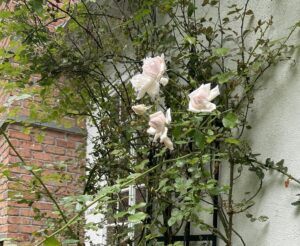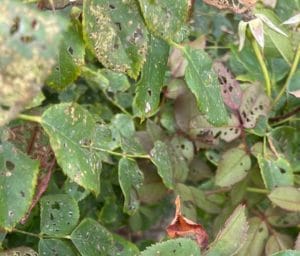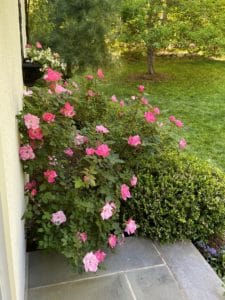Hello, fellow lovers of all things green. I am recovering from a respiratory infection that snuck up on me, much like plant diseases can. Gratefully, I’m on the mend, as are two unsightly rose dilemmas calling for holy moly rose remedies (smile).

What a delight to design Pat’s Garden.
We’ve chatted about the plethora of rose challenges, such as spider mites and aphids that can run amok. Never mind the fungus amongst them, like black spot and powdery mildew they are famous for. Then deer enjoy nibbling, which is odd given roses’ prickly nature. Thankfully, there are more resistant rose varieties. But even with that, dilemmas can arise.
Holy rose remedies are often manageable.
Carolyn’s holy insect dilemma on her Knockout roses is far more manageable than fungus. I suggest Bonide’s Pyrethrin Garden Insect Spray. You can use Pyrethrin, derived from chrysanthemum flowers, even on edible plants. Yet, it immediately impacts an insect’s nervous system, killing them.
It’s the same remedy we used on her Japanese Beetles, and it gives us great satisfaction to watch them become paralyzed—poor things. When using Pyrethrin, be sure not to spray when beneficial pollinators such as bees and butterflies are present, typically early evening. In the fall, we applied Milkyspore to the lawn—a long-term biological control. It’s a safe, all-natural bacteria lethal to grubs but harmless to humans, pets, and beneficial insects.
Pat’s dilemma is more complicated. She sent photos of her climbing roses in distress about five weeks after we fertilized and pruned them. Her Knockout roses were doing beautifully and still are. The climbing roses, previously shy on blooms, filled with buds.
“But only a few buds bloomed,” Pat said, “The others don’t open and turn brown on the canes.”
Fungus is more challenging.
Rachel and Andrew, associate gardening gurus, thought the recent heatwave and dry spell might have invited fungus. During a drought, ensure your roses remain moist using a handy-dandy soil moisture meter costing less than 15 bucks. Of course, remove diseased buds and foliage as best you can.
We primarily rely on organic practices, but treating with a rose systemic is sometimes necessary. The American Rose Society published an informative article, but despite the title, Fungicides Made Simple, culling through the information is a tad complicated. Here’s the skinny:
Rose remedy tips for fungus
There are contact fungicides to spray on the leaves and others you apply with water to the roots—the latter is less risky. Contact fungicides aren’t as effective as systemic ones, which makes sense. Systemic means they absorb into the plant and won’t wash off in the rain.
Bonide’s Rose Shield Systemic Rose & Flower Drench is a popular systemic drench you apply to the soil. They say it controls insect and fungal disease for up to six weeks. However, the product label and safety data sheets are intimidating.
Prevention is the best rose remedy of all.
Like all diseases, prevention is vital. Ensure roses receive six to eight hours of full direct sunlight and are spaced at least two feet apart from other mature plants. When irrigation is needed, only water the roots to prevent wetting the leaves.
The American Rose Society suggests not overfertilizing, which adds further stress to plants, and rotating fungicides to prevent the plant from becoming “resistant to chemical treatments.”
When to apply preventative fungicides
Most fungicides only protect uninfected growth from becoming diseased. So, applying them when conditions are ripe for fungus is best. Blackspot spores tend to germinate between 65-85 degrees on foliage that is moist for seven hours or more—and powdery mildew when it’s dry with high humidity and warm days with cool nights.

Pats Recovered Climbing Rose
A few suggested preventative fungicides include Rose Pride, Rose Defense, and products containing Neem oil. Neem oil is my go-to natural alternative that discourages both fungi and parasites. So, I suggested Pat grab a ladder, spray her climbing roses weekly, and remove diseased buds and foliage until healthy new growth emerges. It’s easy for me to say rather than do, as I’m a tad nervous climbing ladders. But Pat rose to the challenge, and her roses rebounded beautifully.
When you think about it, plant dilemmas parallel health dilemmas we endure as humans. I suppose there’s no such thing as being dilemma-less—smile. But gratefully, our garden of life has delights and discoveries beyond challenges. Finding respite in our gardens and amongst nature helps soothe the soul. At the same time, by nurturing nature, we can improve our health and that of our dear earth.
Garden Dilemmas? AskMaryStone@gmail.com (and your favorite Podcast App.)
There’s more to the story in the Garden Dilemmas Podcast:
Related Stories and Helpful Links:
Enjoy the saga of Carolyn’s Holy Rose Dilemma in Japanese Beetle Time
Link to the American Rose Society
A few products mentioned: Bonide’s Pyrethrin Garden Insect Spray, Bonide’s Rose Shield Systemic Rose & Flower Drench, Neem Oil





